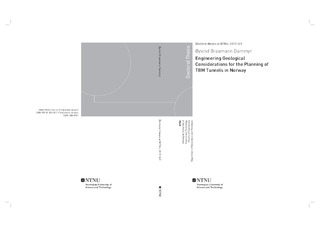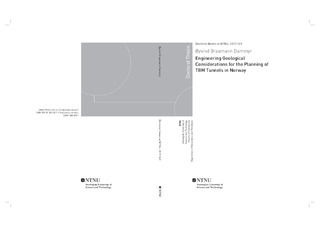| dc.contributor.advisor | Nilsen, Bjørn | |
| dc.contributor.advisor | Thuro, Kurosch | |
| dc.contributor.author | Dammyr, Øyvind Braamann | |
| dc.date.accessioned | 2018-02-08T11:55:21Z | |
| dc.date.available | 2018-02-08T11:55:21Z | |
| dc.date.issued | 2017 | |
| dc.identifier.isbn | 978-82-326-2411-9 | |
| dc.identifier.issn | 1503-8181 | |
| dc.identifier.uri | http://hdl.handle.net/11250/2483498 | |
| dc.description.abstract | The use of tunnel boring machines (TBMs) was extensive in Norway during the larger scale hydropower development between the 1970s and the 1990s, and clients, contractors and research institutions contributed to the technological development that allowed stronger and more massive rocks to be bored. Most of the tunnels had small diameters (< 5 m). Currently, there are large-scale infrastructure developments (both public transport and technical) occurring in Norway, which involve the construction of many new tunnels. Some of these tunnels are being bored with TBMs, and the necessary TBM diameters for future tunnels will often be > 9 m. Due to the high traffic (and importance) of new tunnels and increased construction in rural areas, larger emphasis is being placed on environmental considerations, and reliability, availability, maintenance and safety (RAMS). From a life cycle cost (LCC) perspective there is a desire to find the optimal tunnel concepts to ensure the fulfillment of functional requirements. Some of the most important engineering geological challenges experienced during earlier tunnel boring in Norway have been related to spalling and rock burst in high in situ stress environments, instability due to highly fractured/faulted rock, and large water inflow. These aspects are also typical concerns in Norwegian drill and blast (D&B) tunnels, but it has been realized that TBMs offer less flexibility, and that more careful planning and investigations ahead of a project are important for bored tunnels.
The aims of the thesis are:
• Identify and highlight important engineering geological aspects that should be carefully considered in the planning phase of Norwegian TBM infrastructure tunnels.
• Contribute to research within the respective fields, and provide specific recommendations that project owners and consultants can apply when planning TBM infrastructure tunnels in Norway.
The work contributes within the following engineering geological fields of research, with a focus on TBM infrastructure tunnels:
• Waterproofing concepts
• Ground water drainage and settlement control
• Prediction of brittle failure (spalling and rock burst)
• Feasibility of tunnel boring through weakness zones (incl. high pressure, large water inflow)
The main conclusions following the research conducted in the thesis are:
• Engineering geological challenges normally increase with larger excavation diameter, and carrying out investigations and evaluations of rock mass behavior early enough in the planning process are important to assess the technical feasibility of tunnel boring.
• The TBM waterproofing concepts found to comply with the functional requirements of the Norwegian National Railway Administration, and hence believed to ensure a reliable railway operation (also important for other types of tunnels such as for roads and subways), are the concepts most often used in European infrastructure tunnels. That is the single shell concept (gasketed undrained segmental lining) and the double shell concepts (outer shell of shotcrete or drained segmental lining, and inner shell of drainage layer/membrane and cast concrete).
• In order to avoid pore pressure drop in settlement sensitive soils above urban tunnels, and hence to avoid damage to buildings and infrastructure in the future, functional requirements should take into consideration the total future drainage potential from all tunnels and building pits. It is believed that the use of traditional hard rock TBM-S (TBM-singe shield) machines built with the possibility to convert into static-closed-mode (from where pre-excavation grouting can be performed when the face is pressurized) can be an alternative to D&B in order to better control drainage during tunnel construction.
• Existing research on brittle failure and prediction methods have mostly focused on rock types with isotropic behavior, and the effect of anisotropy has not been fully understood. The results of this thesis suggest that existing prediction methods can be used for foliated/anisotropic rocks as long as: rock strength is considered to be directional-dependent; one considers that failure may occur in, and rotate to other parts of the tunnel-periphery than the location of maximum tangential stress; the range of recommended input parameters and confidence intervals of the prediction methods are considered.
•Tunnel boring through weakness zones in deep Norwegian subsea tunnels is considered one of the most challenging scenarios for a TBM. Since a TBM is often less flexible than D&B, feasibility will directly relate to the identified geological hazards in each case and their potential implication to tunneling. For TBM it is important to identify and plan for the use of available and effective mitigation methods before the onset of construction. Large diameter tunnel boring (> 12 m for road tunnels) through weakness zones in deep Norwegian subsea tunnels has been found to involve a high risk, and hence is not recommended when the water pressure is above ca. 100 m. For lower water pressures TBMs with the option to operate in closed-mode may counteract some of the identified hazards, and can possibly be advantageous over D&B in certain cases. | nb_NO |
| dc.language.iso | eng | nb_NO |
| dc.publisher | NTNU | nb_NO |
| dc.relation.ispartofseries | Doctoral theses at NTNU;2017:169 | |
| dc.relation.haspart | Paper 1:
Dammyr, Øyvind Braamann; Nilsen, Bjørn.
Evaluation of the potential for TBM use in future Norwegian tunneling projects. Rock Engineering and Technology for Sustainable Underground Construction Eurock 2012 – the 2012 ISRM International Symposium
- Is not included due to copyright available at
https://www.onepetro.org/conference-paper/ISRM-EUROCK-2012-034 | |
| dc.relation.haspart | Paper 2;
Dammyr, Øyvind Braamann; Nilsen, Bjørn; Thuro, Kurosch; Grøndal, Jørn.
Possible Concepts for Waterproofing of Norwegian TBM Railway Tunnels. Rock Mechanics and Rock Engineering 2014 ;Volum 47.(3) s. 985-1002
- Is not included due to copyright available at
https://doi.org/10.1007/s00603-013-0388-5 | |
| dc.relation.haspart | Paper 3:
Dammyr, Øyvind
Pressurized TBM-shield tunneling under the subsidence sensitive grounds of Oslo:
Possibilities and limitations
Tunnelling and Underground Space Technology
Volume 66, June 2017, Pages 47-55
https://doi.org/10.1016/j.tust.2017.03.010 | |
| dc.relation.haspart | Paper 4:
Dammyr, Øyvind Braamann.
Prediction of Brittle Failure for TBM Tunnels in Anisotropic Rock: A Case Study from Northern Norway. Rock Mechanics and Rock Engineering 2016 ;Volum 49.(6) s. 2131-2153
- Is not included due to copyright available at
https://doi.org/10.1007/s00603-015-0910-z | |
| dc.relation.haspart | Paper 5:
Dammyr, Øyvind Braamann; Nilsen, Bjørn; Gollegger, Johannes.
Feasibility of tunnel boring through weakness zones in deep Norwegian subsea tunnels. Tunnelling and Underground Space Technology 2017 ;Volum 69. s. 133-146
https://doi.org/10.1016/j.tust.2017.06.012 | |
| dc.title | Engineering Geological Considerations for the Planning of TBM Tunnels in Norway | nb_NO |
| dc.type | Doctoral thesis | nb_NO |
| dc.subject.nsi | VDP::Technology: 500::Rock and petroleum disciplines: 510::Petroleum engineering: 512 | nb_NO |
| dc.description.localcode | Digital fulltext not available | nb_NO |

